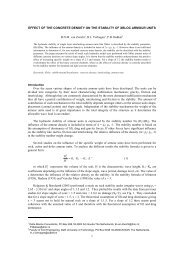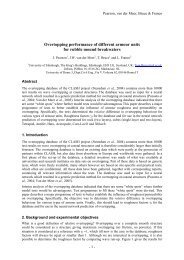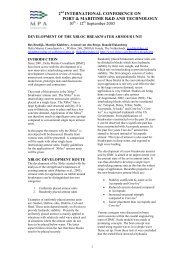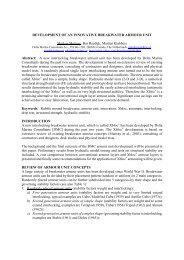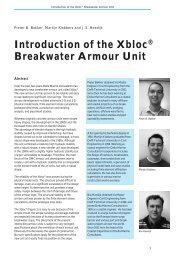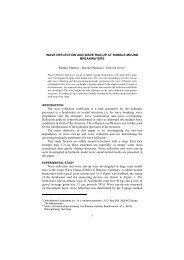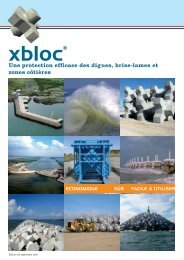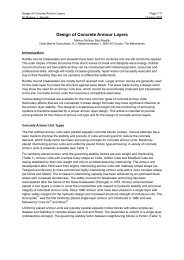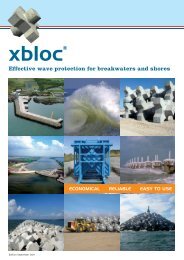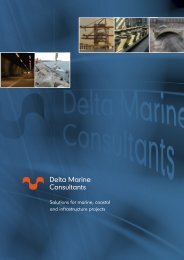Frequently Asked Questions about the Xbloc ® unit [FAQ]
Frequently Asked Questions about the Xbloc ® unit [FAQ]
Frequently Asked Questions about the Xbloc ® unit [FAQ]
Create successful ePaper yourself
Turn your PDF publications into a flip-book with our unique Google optimized e-Paper software.
<strong>Frequently</strong> <strong>Asked</strong> <strong>Questions</strong> <strong>about</strong> <strong>the</strong> <strong>Xbloc</strong> ® <strong>unit</strong> [<strong>FAQ</strong>]<br />
GENERAL<br />
What is <strong>the</strong> <strong>Xbloc</strong> ® ?<br />
The <strong>Xbloc</strong> ® is a pre-cast concrete structural element used in <strong>the</strong> construction of certain<br />
types of marine structures. It is an innovative interlocking <strong>unit</strong>, made from non-reinforced<br />
concrete, designed to protect rubble mound breakwaters and shores over <strong>the</strong> long term<br />
and in extreme conditions. The <strong>unit</strong> is placed in a single layer as <strong>the</strong> outer layer [i.e.<br />
armour] of <strong>the</strong> structure.<br />
What is a rubble mound breakwater?<br />
A breakwater is a structure made of natural stone or concrete elements which gives<br />
shelter to a shoreline, harbour, anchorage, or basin from <strong>the</strong> direct impact of incoming<br />
waves. A rubble mound breakwater normally consists of a core of small size rock covered<br />
with large [heavy] rocks or concrete elements. This outer layer is called <strong>the</strong> armour layer.<br />
An under-layer of rock is provided between <strong>the</strong> core and <strong>the</strong> armour layer.<br />
How does an armour layer of <strong>Xbloc</strong> ® <strong>unit</strong>s protect <strong>the</strong> breakwater?<br />
The <strong>Xbloc</strong> ® armour derives its hydraulic stability from its own weight and by interlocking<br />
with surrounding <strong>unit</strong>s. Due to <strong>the</strong> highly porous armour layer constructed with <strong>Xbloc</strong> ®<br />
<strong>unit</strong>s <strong>the</strong> energy of <strong>the</strong> incoming waves will be absorbed. The <strong>Xbloc</strong> ® armour layer is<br />
<strong>the</strong>refore able to protect <strong>the</strong> rock in <strong>the</strong> under layer from erosion due to waves.<br />
What determines <strong>the</strong> choice between rock and concrete as armour layer?<br />
For design wave heights below 3 m [significant wave height], rock is often economically<br />
viable for use as armour layer. For design wave heights above 4 m extremely large rock<br />
sizes are required which are difficult to obtain, handle and place. Limited availability of<br />
such material leads to greater expense. In areas where good quality rock is difficult to<br />
obtain concrete armour may also be preferred for smaller wave heights.<br />
How big is an <strong>Xbloc</strong> ® <strong>unit</strong>?<br />
The size of an <strong>Xbloc</strong> ® <strong>unit</strong> depends on <strong>the</strong> design wave height expected at <strong>the</strong> breakwater<br />
location. The <strong>Xbloc</strong> ® <strong>unit</strong> has been developed for use in sizes varying from 0.75 m 3 up to<br />
20 m 3 . Using <strong>the</strong> design table, provided in <strong>the</strong> <strong>Xbloc</strong> ® folder or at <strong>the</strong> internet site, <strong>the</strong><br />
appropriate <strong>unit</strong> size can be determined for concept designs. See also <strong>the</strong> guidelines for<br />
<strong>Xbloc</strong> concept designs.<br />
What does interlocking mean?<br />
Interlocking is <strong>the</strong> mechanism by which armour <strong>unit</strong>s can hook into each o<strong>the</strong>r due to <strong>the</strong><br />
shape of <strong>the</strong> <strong>unit</strong>. This increases <strong>the</strong> resistance against wave attack. The advantage of<br />
<strong>unit</strong>s shaped to allow a high degree of interlock over o<strong>the</strong>r shapes where less interlock is<br />
possible, is that smaller and lighter elements can be placed. This reduces <strong>the</strong> cost of a<br />
structure as lighter equipment is required for handling and placement and less concrete is<br />
required for <strong>the</strong> armour layer.
On what type of construction are <strong>the</strong> <strong>Xbloc</strong> ® <strong>unit</strong>s applicable?<br />
The <strong>Xbloc</strong> ® <strong>unit</strong>s are applicable for all marine structures in which a stable armour layer is<br />
required. Examples are breakwaters, groins, shore protection and harbour entrances. The<br />
<strong>Xbloc</strong> ® <strong>unit</strong>s can be applied for new construction works as well as for rehabilitation of<br />
existing structures.<br />
Why are <strong>Xbloc</strong> ® <strong>unit</strong>s placed as a single layer?<br />
The armour layer of a breakwater is relatively expensive as it ei<strong>the</strong>r consists of large size<br />
rocks or concrete <strong>unit</strong>s. It is <strong>the</strong>refore economical to reduce <strong>the</strong> thickness of <strong>the</strong> armour<br />
layer by <strong>the</strong> application of a single armour layer. In <strong>the</strong> past concrete armour <strong>unit</strong>s were<br />
placed in double layers as this was <strong>the</strong> common practice with rock armour layers. More<br />
recent concrete armour <strong>unit</strong>s are designed to be placed in a single layer. It was found<br />
that a single layer of <strong>Xbloc</strong> ® armour <strong>unit</strong>s will result in a highly stable structure. Besides a<br />
major saving in <strong>the</strong> total concrete volume <strong>the</strong> construction time is also significantly<br />
reduced when compared to construction with a double layer of concrete armour <strong>unit</strong>s.<br />
Double layer concrete armour <strong>unit</strong>s are more susceptible to rocking as <strong>the</strong> second layer<br />
does interlock effectively.<br />
Can <strong>the</strong> <strong>Xbloc</strong> ® system be used by all contractors?<br />
The <strong>Xbloc</strong> ® system has been developed for application by all qualified marine contractors.<br />
Normal pre-qualification of contractors is all that is necessary.<br />
What are <strong>the</strong> advantages of <strong>the</strong> <strong>Xbloc</strong> ® compared with o<strong>the</strong>r <strong>unit</strong>s?<br />
The most obvious advantage of <strong>the</strong> <strong>Xbloc</strong> ® <strong>unit</strong> is <strong>the</strong> cost benefit of <strong>the</strong> <strong>unit</strong>. Compared<br />
to o<strong>the</strong>r single layer <strong>unit</strong>s, cost savings in <strong>the</strong> range of 15 % may be anticipated due to<br />
<strong>the</strong> low concrete usage of <strong>the</strong> <strong>Xbloc</strong> ® <strong>unit</strong>. Compared to double layer elements <strong>the</strong> cost<br />
savings are much larger. Additional savings are achieved as less <strong>unit</strong>s are placed.<br />
Fur<strong>the</strong>rmore <strong>the</strong> <strong>unit</strong> is easier to place than o<strong>the</strong>r single layer interlocking <strong>unit</strong>s and this<br />
results in decreased construction time. Ano<strong>the</strong>r major advantage over o<strong>the</strong>r <strong>unit</strong>s is <strong>the</strong><br />
large hydraulic stability [high interlocking] combined with a highly robust shape.<br />
Does <strong>the</strong> <strong>Xbloc</strong> ® <strong>unit</strong> have disadvantages?<br />
Compared to o<strong>the</strong>r armour <strong>unit</strong>s, <strong>the</strong> <strong>Xbloc</strong> ® has no disadvantages. The <strong>Xbloc</strong> ® is<br />
designed as a balance between good hydraulic stability and still remains a strong and<br />
robust <strong>unit</strong>. If for instance <strong>the</strong> interlocking were to be increased by making <strong>the</strong> <strong>unit</strong> more<br />
slender <strong>the</strong> risk of <strong>unit</strong> breakage would increase. With all interlocking <strong>unit</strong>s concrete<br />
quality needs to be well assured as tensile stresses do occur.<br />
<strong>Xbloc</strong> ® is most effective on relatively steep slopes as gravity enhances interlocking.<br />
Therefore <strong>Xbloc</strong> ® is less effective on flat slopes and berms.<br />
How can we get an <strong>Xbloc</strong> ® design?<br />
Delta Marine Consultants may be directly contacted with a request to make a concept<br />
design, without any obligations. A fur<strong>the</strong>r option is to carry out your own concept design,<br />
using <strong>the</strong> <strong>Xbloc</strong> ® design tables. This design can subsequently be checked by DMC, again
without any obligation on your part. DMC has extensive expertise in <strong>the</strong> field of<br />
breakwaters and shore protection, and would be pleased to assist at <strong>the</strong> detailed design<br />
phase of <strong>the</strong> project. At this stage confirmative model tests should be included for which<br />
model <strong>Xbloc</strong> ® armour <strong>unit</strong>s can be hired from DMC. For application of <strong>the</strong> <strong>Xbloc</strong> ® <strong>the</strong><br />
detailed design should be checked by DMC.
ECONOMICS & FINANCE<br />
What are <strong>the</strong> cost savings using <strong>Xbloc</strong> ® <strong>unit</strong>s?<br />
Compared to o<strong>the</strong>r single layer <strong>unit</strong>s cost savings can readily amount to approximately 15<br />
% due to <strong>the</strong> lower quantity of concrete demanded by <strong>Xbloc</strong> ® armour <strong>unit</strong>s. Compared to<br />
double layer <strong>unit</strong>s <strong>the</strong> cost savings are much larger. Additional savings are achieved as<br />
fewer <strong>unit</strong>s are required. As <strong>unit</strong> orientation is not prescribed <strong>the</strong> <strong>unit</strong> is easier to place<br />
than o<strong>the</strong>r single layer interlocking <strong>unit</strong>s and this results in decreased construction time.<br />
What are <strong>the</strong> costs of <strong>the</strong> armour layer in relation to <strong>the</strong> overall costs of <strong>the</strong><br />
structure?<br />
In general <strong>the</strong> cost of a breakwater depends on its size. The costs of <strong>the</strong> armour layer can<br />
amount to 30 % of <strong>the</strong> cost of <strong>the</strong> complete structure, depending on <strong>the</strong> water depth.<br />
Fur<strong>the</strong>rmore a breakwater built in an area with a rough wave climate and a high extreme<br />
design wave requires a heavier armour layer than a more sheltered location. As larger<br />
armour <strong>unit</strong>s have a larger concrete volume this has an influence on <strong>the</strong> costs of <strong>the</strong><br />
armour layer and <strong>the</strong> complete structure.<br />
What is <strong>the</strong> lifetime of a structure with <strong>Xbloc</strong> ® <strong>unit</strong>s?<br />
The lifetime of a structure containing <strong>Xbloc</strong> ® <strong>unit</strong>s is determined by <strong>the</strong> relationship<br />
between <strong>the</strong> design conditions and <strong>the</strong> chosen <strong>unit</strong> size. In many cases armour <strong>unit</strong>s are<br />
designed to withstand extreme storm conditions that will occur only once in 100 years<br />
time span. A <strong>unit</strong> size is chosen such that <strong>the</strong> <strong>Xbloc</strong> ® structure will withstand <strong>the</strong>se<br />
conditions without any damage. Concrete durability is <strong>the</strong> o<strong>the</strong>r factor affecting <strong>the</strong> lifetime<br />
and this is a function of <strong>the</strong> concrete mix design and workmanship.<br />
Does a structure with <strong>Xbloc</strong> ® armour <strong>unit</strong>s require maintenance?<br />
A structure containing <strong>Xbloc</strong> ® armour <strong>unit</strong>s is designed to incur no damage during <strong>the</strong><br />
most extreme event expected during its life-time. Therefore no maintenance of an <strong>Xbloc</strong> ®<br />
breakwater should be required provided that <strong>the</strong> design has been based on correct input<br />
data and it is constructed according to <strong>the</strong> <strong>Xbloc</strong> ® specifications.<br />
What is <strong>the</strong> amount of <strong>the</strong> royalty fee that will be charged?<br />
Please contact Delta Marine Consultants who will be pleased to provide a quotation of<br />
royalty fees for your specific project.<br />
What does Delta Marine Consultants offer for this royalty fee?<br />
The fee provides for <strong>the</strong> assistance of DMC during <strong>the</strong> most important phases of <strong>the</strong><br />
project. This includes a check of <strong>the</strong> <strong>Xbloc</strong> ® design if made by o<strong>the</strong>rs, toge<strong>the</strong>r with<br />
assistance during physical model testing. Fur<strong>the</strong>rmore on-site assistance during <strong>unit</strong><br />
casting and placement will be provided along with technical specifications, formwork<br />
drawings and a placement plan.<br />
DMC has already invested heavily in <strong>the</strong> research and development of <strong>the</strong> <strong>Xbloc</strong> ® armour<br />
<strong>unit</strong>. Additional research is ongoing and will continue in future to expand <strong>the</strong> range of<br />
applications of <strong>Xbloc</strong> ® armour <strong>unit</strong>s.
Why should we pay royalties for <strong>the</strong> use of a patented <strong>unit</strong> if <strong>the</strong>re are also<br />
armour <strong>unit</strong>s available for which <strong>the</strong> patent has expired?<br />
The cost saving associated with use of <strong>the</strong> patented <strong>Xbloc</strong> ® may be expected to exceed by<br />
far <strong>the</strong> royalties paid for <strong>the</strong> use of <strong>the</strong> <strong>Xbloc</strong> ® system. Thus, even if a non-patented<br />
armour <strong>unit</strong> is chosen, <strong>the</strong> application of <strong>the</strong> <strong>Xbloc</strong> ® <strong>unit</strong> should still be economically<br />
viable. In addition <strong>the</strong> use of all armour <strong>unit</strong>s may necessitate assistance from specialists<br />
during <strong>the</strong> design, model testing, production and placement stages. This assistance is<br />
included in <strong>the</strong> <strong>Xbloc</strong> ® royalty fee. Considering patent free <strong>unit</strong>s it should be noted that<br />
copyright and trademark laws are applicable.
HYDRAULIC STABILITY<br />
What is ‘hydraulic stability’ of a breakwater?<br />
Hydraulic stability is <strong>the</strong> resistance of <strong>the</strong> breakwater in general and of <strong>the</strong> armour layer<br />
in particular against <strong>the</strong> forces generated by incoming waves.<br />
How has <strong>the</strong> hydraulic stability of <strong>the</strong> <strong>Xbloc</strong> been determined?<br />
The hydraulic stability of <strong>the</strong> <strong>Xbloc</strong> ® has been determined by means of small scale<br />
hydraulic model tests. Model tests have been carried out at laboratories all over <strong>the</strong><br />
world.<br />
How does <strong>the</strong> hydraulic stability of <strong>the</strong> <strong>Xbloc</strong> ® compare to o<strong>the</strong>r <strong>unit</strong>s?<br />
From <strong>the</strong> first 2D tests at Delft Hydraulics it was found that <strong>the</strong> hydraulic stability is at<br />
least comparable with <strong>the</strong> hydraulic stability of o<strong>the</strong>r single layer armour <strong>unit</strong>s. The<br />
Hudson equation [Kd = 16] or <strong>the</strong> Van der Meer’s equation [stability number = 2.8] can<br />
be used for preliminary design, based on a slope angle of 3:4. In fur<strong>the</strong>r 2D model testing<br />
even better stability results were obtained, as a result of an improved <strong>unit</strong> placement<br />
method. This results in additional safety of <strong>the</strong> design.<br />
What is <strong>the</strong> safety factor of <strong>the</strong> <strong>Xbloc</strong> ® <strong>unit</strong>?<br />
The design values stated above are based on a safety factor of 1.25. This means that a<br />
design wave could be exceeded by 25% before <strong>the</strong> first <strong>unit</strong> extractions would occur. The<br />
safety on <strong>unit</strong> weight is <strong>the</strong>refore 1.95 [(1.25) 3 ].<br />
How are such parameters accounted for in <strong>the</strong> stability assessment?<br />
During hydraulic model tests, <strong>the</strong> effects of different wave steepness were analysed.<br />
Moreover <strong>the</strong> crest height was varied and deepwater and shallow water waves were<br />
analysed. The tests indicate that <strong>the</strong> governing factor for <strong>the</strong> stability of <strong>the</strong> <strong>Xbloc</strong> ® is <strong>the</strong><br />
wave height and not <strong>the</strong> wave steepness or <strong>the</strong> wave period.<br />
On what slope angles can <strong>the</strong> <strong>Xbloc</strong> ® be laid?<br />
The <strong>Xbloc</strong> ® has been tested on slope angles of 3 [V]: 4 [H] and 1 [V]: 1.5 [H], as such<br />
slopes are commonly used for single layer armour <strong>unit</strong>s. Also tests have been carried out<br />
for a slope of 1 [V] : 2 [H], as such a slope may be required in severe seismic areas for<br />
geotechnical reasons. <strong>Xbloc</strong> ® has been applied on slopes of 3:4 and 1:2. Note that for<br />
slopes flatter than 3:4 no reduction in weight is advised. For <strong>Xbloc</strong> ® application at<br />
different slope angles <strong>the</strong> stability should be investigated in <strong>the</strong> model tests and larger<br />
<strong>unit</strong> seizes may be required. See also <strong>the</strong> Guidelines for <strong>Xbloc</strong> Concept Designs.<br />
What is <strong>the</strong> influence of wave period on <strong>the</strong> stability?<br />
Tests have been performed with various wave heights and various wave periods. The<br />
wave steepness was varied between 2% and 6%. For all values of wave steepness <strong>the</strong><br />
hydraulic stability is excellent.
What is <strong>the</strong> influence of breaking and non-breaking waves on stability?<br />
Tests have been performed with both breaking and non-breaking wave conditions. No<br />
significant influence of ei<strong>the</strong>r breaking or non-breaking waves on <strong>the</strong> hydraulic stability<br />
was observed.<br />
What is <strong>the</strong> influence of a steep foreshore on <strong>the</strong> stability?<br />
Based on experience with o<strong>the</strong>r armour <strong>unit</strong>s it is known that <strong>the</strong> effect of a steep<br />
foreshore may be expected to reduce <strong>the</strong> stability of <strong>the</strong> armour layer. Therefore where<br />
<strong>the</strong> foreshore is steeper than 1:30 <strong>the</strong> armour mass in conceptual design should be<br />
increased. See also <strong>the</strong> Guidelines for <strong>Xbloc</strong> Concept Designs.<br />
Are larger <strong>unit</strong>s required for <strong>the</strong> roundhead of a breakwater?<br />
In common with o<strong>the</strong>r single layer armour <strong>unit</strong>s <strong>the</strong> roundhead may normally be expected<br />
to be constructed of armour <strong>unit</strong>s with a mass that is <strong>about</strong> 25% heavier than <strong>the</strong> <strong>unit</strong>s at<br />
<strong>the</strong> trunk. The slope angle of <strong>the</strong> roundhead may be kept equal to <strong>the</strong> slope angle of <strong>the</strong><br />
trunk.<br />
Are model tests always required?<br />
In general model tests are an essential part of <strong>the</strong> design scope of breakwaters. This is<br />
considered to be best practice.<br />
Where can we get model <strong>unit</strong>s for model testing?<br />
<strong>Xbloc</strong> ® armour <strong>unit</strong>s of various sizes can be hired through Delta Marine Consultants. DMC<br />
will also provide instructions on placement of <strong>the</strong> <strong>unit</strong>s.<br />
How does self-repairing work?<br />
A self-healing process can take place when an <strong>Xbloc</strong> ® <strong>unit</strong> is taken out of <strong>the</strong> slope by<br />
wave action during an extreme overload situation [> 125% of design wave conditions].<br />
The result would be that under wave attack one or two <strong>Xbloc</strong> ® above <strong>the</strong> hole so caused<br />
would settle slightly towards <strong>the</strong> hole and would automatically interlock with its<br />
neighbouring <strong>unit</strong>s. This would partly re-establish <strong>the</strong> stability of <strong>the</strong> armour layer. Due to<br />
such rearrangement of <strong>the</strong> armour <strong>unit</strong>s <strong>the</strong> slope would be able to withstand such<br />
conditions and probably even more extreme wave conditions before failure of <strong>the</strong> armour<br />
layer would occur.<br />
When do <strong>the</strong> armour <strong>unit</strong>s start to ‘rock’?<br />
Some rocking of model armour <strong>unit</strong>s may be observed during physical model testing.<br />
When model tests are repeated rocking generally decreases as interlocking increases due<br />
to better packing. In extreme wave conditions still some rocking may be observed.<br />
What is <strong>the</strong> effect of a rocking <strong>unit</strong> on a slope?<br />
Severe rocking of armour <strong>unit</strong>s will cause high forces in <strong>the</strong> armour <strong>unit</strong>s. Under wave<br />
conditions that may typically be expected during <strong>the</strong> lifetime of <strong>the</strong> structure limited<br />
rocking of some <strong>unit</strong>s may be expected. Fur<strong>the</strong>rmore, from extensive calculations and<br />
prototype drop tests it was found in contrast with some o<strong>the</strong>r armour <strong>unit</strong>s, that <strong>the</strong>
<strong>Xbloc</strong> ® <strong>unit</strong> can deal with forces related to limited rocking. Therefore rocking of a few<br />
<strong>unit</strong>s is not regarded to be a serious threat for a structure built using <strong>Xbloc</strong> ® armour.<br />
How much overtopping occurs over an <strong>Xbloc</strong> ®<br />
to o<strong>the</strong>r <strong>unit</strong>s?<br />
armoured breakwater compared<br />
Results of <strong>the</strong> CLASH tests indicated that <strong>the</strong> overtopping of a <strong>Xbloc</strong> ® amrour layer is<br />
approximately <strong>the</strong> same as it would be with o<strong>the</strong>r single layer armour <strong>unit</strong>s.<br />
What is <strong>the</strong> influence of oblique wave attack on <strong>the</strong> stability of <strong>the</strong> armour<br />
<strong>unit</strong>s?<br />
In <strong>the</strong> 3D tests it was found that <strong>the</strong> stability of <strong>the</strong> armour layer increases for oblique<br />
wave attack. The number of oblique tests undertaken to date is insufficient to enable<br />
determination of a reduction coefficient for design purposes.<br />
What is <strong>the</strong> size of <strong>the</strong> under layer between <strong>the</strong> <strong>unit</strong>s and <strong>the</strong> core?<br />
The size of <strong>the</strong> under layer depends on <strong>the</strong> size of <strong>the</strong> <strong>unit</strong>s. In <strong>the</strong> design table <strong>the</strong><br />
required under layer in a standard rock grading is displayed for each <strong>Xbloc</strong> ® <strong>unit</strong> size.<br />
What kind of supporting toe does an armour layer of <strong>Xbloc</strong> ® <strong>unit</strong>s require?<br />
A stable toe solution is made with <strong>the</strong> Xbase ® toe <strong>unit</strong> with a rock berm. Read more <strong>about</strong><br />
Xbase ® at this site.
STRUCTURAL INTEGRITY<br />
What is meant by structural integrity?<br />
Structural integrity is <strong>the</strong> robustness or strength of a single <strong>unit</strong>: <strong>the</strong> resistance of an<br />
armour <strong>unit</strong> against forces due to handling, placement and movement under extreme<br />
wave attack [rocking].<br />
How has <strong>the</strong> structural integrity of <strong>the</strong> <strong>Xbloc</strong> been determined?<br />
The structural integrity of <strong>the</strong> <strong>Xbloc</strong> ® has been determined by Finite Element [FE]<br />
calculations. With <strong>the</strong> aid of FE calculations using standard load cases <strong>the</strong> tensile stresses<br />
in <strong>the</strong> <strong>Xbloc</strong> ® <strong>unit</strong> and o<strong>the</strong>r single layer armour <strong>unit</strong>s were determined. Fur<strong>the</strong>rmore<br />
prototype drop tests have been performed to check <strong>the</strong> validity of <strong>the</strong> calculations.<br />
How does <strong>the</strong> strength of <strong>the</strong> <strong>Xbloc</strong> ® <strong>unit</strong> compare to o<strong>the</strong>r <strong>unit</strong>s?<br />
From both Finite Element calculations as well as prototype drop tests it can be concluded<br />
that <strong>the</strong> maximum tensile stresses in <strong>the</strong> <strong>Xbloc</strong> ® <strong>unit</strong> are certainly no greater than <strong>the</strong><br />
tensile stresses in o<strong>the</strong>r single layer <strong>unit</strong>s. Due to its shape <strong>the</strong> <strong>Xbloc</strong> ® is a robust <strong>unit</strong>.<br />
This requires <strong>the</strong> use of standard non-reinforced concrete with a minimum concrete<br />
tensile strength of only 2.5 N/mm 2 . O<strong>the</strong>r modern single layer armour <strong>unit</strong>s require<br />
concrete with a higher minimum tensile strength.<br />
Why is this strength so important for a <strong>unit</strong>?<br />
During handling and placement <strong>the</strong> <strong>unit</strong> must be strong enough to cope with <strong>the</strong> stresses<br />
imposed. Once placed on <strong>the</strong> breakwater an armour <strong>unit</strong> is subject to wave forces which<br />
can be extremely high during storms. Extreme wave action can cause small movements<br />
[i.e. rocking] of <strong>unit</strong>s. In <strong>the</strong> past this caused failure of o<strong>the</strong>r proprietary armour <strong>unit</strong>s<br />
and subsequent failure of <strong>the</strong> whole breakwater. An armour <strong>unit</strong> should <strong>the</strong>refore be<br />
strong enough to resist all loads that may be expected during <strong>the</strong> lifetime of <strong>the</strong><br />
structure.<br />
What are <strong>the</strong> weak spots of <strong>the</strong> <strong>unit</strong> considering breakage of <strong>the</strong> <strong>unit</strong>?<br />
Following from <strong>the</strong> finite element calculations for certain standard loads it was found that<br />
<strong>the</strong> highest tensile stresses in <strong>the</strong> concrete occur at <strong>the</strong> transition between <strong>the</strong> X-shaped<br />
base and <strong>the</strong> nose. In order to decrease <strong>the</strong> tensile forces a chamfer or fillet has been<br />
introduced between <strong>the</strong> base and <strong>the</strong> nose. The prototype drop tests were however<br />
performed with <strong>unit</strong>s where no chamfer or fillet had been incorporated and even without<br />
<strong>the</strong> improvement <strong>the</strong> strength of <strong>the</strong> <strong>unit</strong> was excellent.<br />
What kind of damage does occur during droptests?<br />
In <strong>the</strong> tests it was found that <strong>the</strong> sharp edges of <strong>the</strong> concrete will crush, leading to a<br />
negligible decrease of <strong>the</strong> <strong>unit</strong> mass. At large fall heights on to a rigid concrete base a<br />
nose or a leg broke off, depending on <strong>the</strong> particular orientation of <strong>the</strong> drop. Stresses<br />
inflicting this kind of damage are not expected to occur during <strong>the</strong> life-time of an <strong>Xbloc</strong> ® .
Is salty water a threat to <strong>the</strong> <strong>Xbloc</strong> ® concrete?<br />
Saltwater penetration is a threat to reinforced concrete, as <strong>the</strong> steel will corrode easier in<br />
a saline environment. The <strong>Xbloc</strong> ® is made of non-reinforced concrete, which performs<br />
very well in a marine environment provided that o<strong>the</strong>r properties (minimum cement<br />
content; water/cement ratio) comply with normal code requirements. There are various<br />
examples where non-reinforced concrete has been made using seawater that are known<br />
to be very durable.<br />
Does <strong>the</strong> <strong>Xbloc</strong> ® consist of reinforced concrete?<br />
The <strong>Xbloc</strong> ® consists of non-reinforced concrete, similar to o<strong>the</strong>r single layer armour <strong>unit</strong>s.<br />
What grade of concrete should used?<br />
As <strong>the</strong> <strong>Xbloc</strong> ® has a robust shape, a standard C25/30 (Eurocode) concrete quality with a<br />
minimum tensile strength of 2.5 MPa (tensile splitting strength) at 28 days can be sed.<br />
Can heavy aggregates be used in <strong>the</strong> concrete?<br />
Use of heavy aggregates will increase <strong>the</strong> specific weight of <strong>the</strong> concrete which means<br />
that smaller <strong>unit</strong>s can be used. However this is only economical if <strong>the</strong> aggregates are<br />
readily available as hydraulic stability of <strong>the</strong> element is not related to <strong>unit</strong> weight only.<br />
What is <strong>the</strong> risk of cracking due to heat development during hydratation?<br />
Calculations have been made with a Finite Element Model which simulates concrete<br />
curing. These calculations have been calibrated using measurements taken during curing<br />
of a 3 m 3 <strong>unit</strong>. The calculations show that hydratation cracking does not occur.<br />
Calculations have been carried out for <strong>unit</strong>s up to 20 m 3 . For very large <strong>unit</strong>s in adverse<br />
environmental conditions Delta Marine Consultants can perform numerical analysis to<br />
check whe<strong>the</strong>r special measures are required to prevent hydratation cracking.<br />
Is it possible to use concrete with a lower quality, since <strong>the</strong> <strong>Xbloc</strong> ®<br />
structurally strong <strong>unit</strong>?<br />
is a<br />
The use of a lower concrete quality is not recommended as <strong>the</strong> tensile strength is<br />
reduced. Nei<strong>the</strong>r is a higher quality concrete recommended, since this material may also<br />
display more brittle behaviour.
PRODUCTION AND PLACEMENT<br />
Which parties have been involved in <strong>the</strong> development of <strong>the</strong> shape of <strong>the</strong> mould?<br />
The mould has been developed utilising expertise of concrete specialists as well as mould<br />
specialists. Based on <strong>the</strong>ir advice different types of <strong>Xbloc</strong> ® moulds have been developed.<br />
The choice of a particular mould option can be made by <strong>the</strong> contractor depending on his<br />
preferences. The four <strong>Xbloc</strong> ® prototypes, each 4 m 3 in size, were cast using a horizontal<br />
mould. With this type of mould, <strong>the</strong> upper nose of <strong>the</strong> <strong>Xbloc</strong> ® is cast on top of <strong>the</strong> X<br />
approximately one hour after <strong>the</strong> rest is cast. The prototype drop tests indicated that this<br />
had no affect whatsoever on <strong>the</strong> strength of that particular nose. In a later stage in <strong>the</strong><br />
<strong>Xbloc</strong> ® development vertical formwork was constructed and used for <strong>Xbloc</strong> ® <strong>unit</strong><br />
production.<br />
How can we get <strong>the</strong> <strong>Xbloc</strong> ® mould for our preferred sizes?<br />
Depending on <strong>the</strong> required <strong>Xbloc</strong> ® <strong>unit</strong> size, ready-for-use <strong>Xbloc</strong> ® moulds may be<br />
available for <strong>the</strong> contractor. Please contact Delta Marine Consultants to check mould<br />
availability. If no existing moulds are available, steel moulds can be ordered through<br />
DMC. Alternatively it would be possible to have <strong>the</strong> moulds manufactured locally using <strong>the</strong><br />
mould drawings provided by DMC.<br />
How do you compact <strong>the</strong> concrete?<br />
The concrete may be compacted using vibration pokers as used in standard concrete<br />
works. The nose of <strong>the</strong> <strong>Xbloc</strong> ® can readily be compacted by providing an opening in <strong>the</strong><br />
nose of <strong>the</strong> mould.<br />
What is <strong>the</strong> production rate of <strong>the</strong> <strong>Xbloc</strong> ® ?<br />
Under normal circumstances it should be possible to attain a 1-day production cycle. In<br />
cold wea<strong>the</strong>r conditions additional measures may have to be taken to achieve this<br />
production rate. Under good climatic conditions even 2 <strong>Xbloc</strong> ® <strong>unit</strong>s can be made per<br />
mould per day.<br />
After how many days can <strong>the</strong> block be transported?<br />
The <strong>unit</strong> can be lifted as soon as a compressive strength of 15 MPa is reached. This value<br />
may be typically reached after 3 days depending on <strong>the</strong> conditions. In some projects it<br />
has been possible to move <strong>the</strong> <strong>Xbloc</strong> ® <strong>unit</strong>s with a shovel equipped with a modified fork<br />
after 1 day. Feel free to contact us to provide you with indications for your specific<br />
project.<br />
What o<strong>the</strong>r specifications are applicable?<br />
The complete specifications and recommendations are included in a document that can be<br />
obtained by Delta Marine Consultants.<br />
What are <strong>the</strong> requirements regarding placement?<br />
The recommended placement density depends on <strong>the</strong> size of <strong>the</strong> <strong>unit</strong> and may be found<br />
in <strong>the</strong> design table. The required placement density must lie between 98 % and 105 % of
<strong>the</strong> recommended packing density. Fur<strong>the</strong>rmore each <strong>Xbloc</strong> ® must be secured by two<br />
o<strong>the</strong>r <strong>unit</strong>s and must be in contact with <strong>the</strong> under layer.<br />
Are <strong>the</strong> <strong>Xbloc</strong> ® <strong>unit</strong>s easy to place compared to o<strong>the</strong>r <strong>unit</strong>s?<br />
Yes, this is one main advantage of <strong>the</strong> <strong>Xbloc</strong> ® <strong>unit</strong> compared to o<strong>the</strong>r single layer <strong>unit</strong>s.<br />
Due to its shape <strong>the</strong> <strong>unit</strong> can readily find a stable position on <strong>the</strong> slope. In contrast to<br />
o<strong>the</strong>r single layer armour <strong>unit</strong>s no orientation of <strong>the</strong> <strong>unit</strong> is specified. This fur<strong>the</strong>r<br />
increases <strong>the</strong> placement speed.<br />
If <strong>Xbloc</strong> ® are so easy to place, why does Delta Marine Consultants have to<br />
provide assistance?<br />
DMC experience with <strong>Xbloc</strong> ® placement is invaluable and is essential to ensure swift <strong>unit</strong><br />
placement toge<strong>the</strong>r with good packing density. Assistance from Delta Marine Consultants<br />
during <strong>unit</strong> placement is included in <strong>the</strong> royalty fee.<br />
Is <strong>the</strong> assistance of divers required for placement under water?<br />
Due to its shape <strong>the</strong> <strong>Xbloc</strong> ® <strong>unit</strong>s are easier to place than o<strong>the</strong>r single layer <strong>unit</strong>s. This<br />
decreases <strong>the</strong> need for assistance from divers. Underwater survey equipment such as<br />
Echoscope and cameras have successfully been used.<br />
How fast can <strong>Xbloc</strong> ® be placed?<br />
From experience with <strong>unit</strong> placement in <strong>the</strong> <strong>Xbloc</strong> ® projects that have been completed<br />
and that are under construction, and in scale models (including slope construction for <strong>the</strong><br />
model tests) it was found that <strong>the</strong> <strong>Xbloc</strong> ® armour <strong>unit</strong>s are more straightforward and<br />
faster to place than o<strong>the</strong>r single layer armour <strong>unit</strong>s. This is due to <strong>the</strong> symmetry and <strong>the</strong><br />
number of interlocking faces of <strong>the</strong> <strong>Xbloc</strong> ® <strong>unit</strong>: <strong>the</strong> <strong>unit</strong> can easily find an interlocking<br />
position. However, <strong>the</strong> exact placement rate is depending on <strong>the</strong> project specific<br />
conditions. Placement rates of up to 40 <strong>Xbloc</strong>s per hour have been achieved with an<br />
excavator placing 2 m 3 <strong>Xbloc</strong>s above water. Typically <strong>Xbloc</strong> ® placement rates ly between<br />
8 and 25 blocks per hour, depending on <strong>the</strong> location, above/below water and use of<br />
excavator or wire crane. Please contact us for more information.<br />
What equipment is required for <strong>unit</strong> placement?<br />
The <strong>unit</strong>s may be placed using a crane equipped with a sling, a hook or a clamp. The<br />
optimal position of <strong>the</strong> <strong>unit</strong>s during placement is with a leg of <strong>the</strong> <strong>unit</strong> pointing<br />
downwards, ensuring easy placement. A clamp may also be used in combination with<br />
notches in one of <strong>the</strong> legs of <strong>the</strong> <strong>unit</strong>.<br />
How do you deal with loose <strong>Xbloc</strong> ® ?<br />
Loose blocks should simply be replaced to enhance interlocking capacity.<br />
What is meant by random <strong>unit</strong> placement? Does it mean that <strong>the</strong> <strong>unit</strong>s are<br />
thrown onto a slope?<br />
Random placement means that <strong>the</strong> orientation of <strong>the</strong> <strong>unit</strong>s may vary. This does not mean<br />
that <strong>the</strong> <strong>unit</strong>s are thrown upon <strong>the</strong> slope. The <strong>unit</strong>s are placed individually, one by one<br />
upon a slope, just as with heavy rock and o<strong>the</strong>r armour <strong>unit</strong>s.
Do <strong>the</strong> sharp edges of <strong>the</strong> <strong>unit</strong>, suffer damage during handling and placement?<br />
Some minor damage may occur, but this does not affect <strong>the</strong> strength or stability of <strong>the</strong><br />
<strong>unit</strong>.<br />
How do you realise <strong>the</strong> required packing density in practice?<br />
When <strong>the</strong> advised horizontal distance between <strong>the</strong> <strong>unit</strong>s is achieved, this will result in a<br />
placement density within <strong>the</strong> required range of <strong>the</strong> specified placement density. A<br />
properly placed bottom row of <strong>unit</strong>s will specially contribute to achieve this density.<br />
Fur<strong>the</strong>rmore, in each project <strong>the</strong> placement should normally start with a trial placement<br />
of <strong>the</strong> <strong>unit</strong>s during which <strong>the</strong> crane driver and o<strong>the</strong>r supervisors will be guided by an<br />
experienced Delta Marine Consultants specialist.


![Frequently Asked Questions about the Xbloc ® unit [FAQ]](https://img.yumpu.com/24141057/1/500x640/frequently-asked-questions-about-the-xbloc-aar-unit-faq.jpg)
